Effects of Si Addition on Interfacial Microstructure and Corrosion Resistance of Hot-Dip Zn–Al–Mg–Si Alloy-Coated Steel
Abstract
1. Introduction
2. Materials and Methods
3. Results and Discussion
4. Conclusions
- Si addition improves the microstructure, electrochemical behavior, and corrosion resistance of Zn–Mg–Al alloy coatings.
- Fe–Zn IMC layers form in the Zn–Al–Mg coatings owing to the dissolution of a large amount of Fe during the dipping process.
- Coating delamination, along with crack formation, occurs at the interface owing to the formation of brittle Fe–Zn IMCs.
- Si addition leads to the formation of a stable Fe2Al3Si inhibition layer, which suppresses interdiffusion and enhances coating adhesion.
- Si addition induces acicular Mg2Si IMC formation at the grain boundaries and in the ternary alloy region, thereby reducing the surface roughness.
- The observed superior long-term performance of the coatings indicates that their corrosion resistance improves with increasing Si content.
- In the SST, no red rust is observed on the sample coating containing 0.5 wt.% of Si even after 2600 h.
Author Contributions
Funding
Data Availability Statement
Acknowledgments
Conflicts of Interest
References
- Hoque, M.A.; Yao, C.W.; Lian, I.; Zhou, J.; Jao, M.; Huang, Y.C. Enhancement of corrosion resistance of a hot-dip galvanized steel by superhydrophobic top coating. MRS Commun. 2022, 12, 415–421. [Google Scholar] [CrossRef]
- Chakraborty, A.; Ghosh, R.; Sudan, M.; Mondal, A. Improvement in hot dip galvanized coating microstructure and properties by pre-metallic deposition on steel surface: A comprehensive review. Surf. Coat. Technol. 2002, 449, 128972. [Google Scholar] [CrossRef]
- Ding, C.; Ma, Z.; Liu, S.; Zhao, J.; Luo, Q.; Liu, H.; Wu, G.; Zhang, J. Research on design and microstructure of hot-dip Zn-Al-Mg/Sn alloy. Mater. Charact. 2022, 185, 111746. [Google Scholar] [CrossRef]
- Kania, H.; Bierońska, M. Corrosion resistance of Zn-31AlMg coatings obtained by batch hot dip method. Solid State Phenom. 2014, 212, 167–172. [Google Scholar] [CrossRef]
- Oh, M.S.; Kim, S.H.; Kim, J.S.; Lee, J.W.; Shon, J.H.; Jin, Y.S. Surface and cut-edge corrosion behavior of Zn-Mg-Al alloy-coated steel sheets as a function of the alloy coating microstructure. Met. Mater. Int. 2016, 22, 26–33. [Google Scholar] [CrossRef]
- Lim, Y.; Jang, B.; Koh, J. Effect of welding parameters on porosity formation in weld beads of galvanized steel pipes produced with gas metal arc welding. J. Weld. Join. 2012, 30, 440–444. [Google Scholar]
- Kim, Y.; Shin, K.S.; Jeon, S.H.; Chin, K.G.; Lee, J. The influence of the dew point on the wettability of twinning-induced-plasticity steels by liquid Zn-0.23-wt% Al. Corros. Sci. 2014, 85, 364–371. [Google Scholar] [CrossRef]
- Qiao, C.; Shen, L.; Hao, L.; Mu, X.; Dong, J.; Ke, W.; Liu, J.; Liu, B. Corrosion kinetics and patina evolution of galvanized steel in a simulated coastal-industrial atmosphere. J. Mater. Sci. Technol. 2019, 35, 2345–2356. [Google Scholar] [CrossRef]
- Bian, J.; Zhu, Y.; Liu, X.; Wang, G. Development of Hot Dip Galvanized Steel Strip and Its Application in Automobile Industry. J. Iron Steel Res. Int. 2006, 13, 47–50. [Google Scholar] [CrossRef]
- Chen, L.; Fourmentin, R.; McDermid, J.R. Morphology and kinetics of interfacial layer formation during continuous hot-dip galvanizing and galvannealing. Metall. Mater. Trans. A 2008, 39, 2128–2142. [Google Scholar] [CrossRef]
- Kim, K.; Grandhi, S.; Oh, M.S. Improving the Coatability of Zn–Mg–Al Alloy on Steel Substrate by the Surface Pretreatment of SnCl2-Added Zinc Ammonium Chloride. Appl. Sci. 2023, 13, 950. [Google Scholar] [CrossRef]
- Manna, M. Effect of Fluxing Chemical: An Option for Zn-5wt.%Al Alloy Coating on Wire Surface by Single Hot Dip Process. Surf. Coat. Technol. 2011, 25, 3716–3721. [Google Scholar] [CrossRef]
- Du, A.; Huo, Y.; Hu, J. Study of Fluxing Process for Hot Dipping Galfan Alloy on Steel Wire. Adv. Mater. Res. 2012, 383–390, 1901–1904. [Google Scholar] [CrossRef]
- Shibli, S.M.A.; Manu, R.; Dilimon, V.S. Effect of nickel-rich barrier layer on improvement of hot-dip zinc coating. App. Surf. Sci. 2005, 245, 179–185. [Google Scholar] [CrossRef]
- Manna, M.; Dutta, M. Improvement in galvanization and galvannealing characteristics of DP 590 steel by prior Cu or Cu–Sn flash coating. Surf. Coat. Technol. 2014, 251, 29–37. [Google Scholar] [CrossRef]
- Samanta, S.A.; Halder, K.; Deo, Y.; Guha, S.; Dutta, M. Effect of Mn and Cr on the selective oxidation, surface segregation and hot-dip Zn coatability. Surf. Coat. Technol. 2019, 377, 124908. [Google Scholar] [CrossRef]
- Xu, B.; Phelan, D.; Dippenaar, R. Role of silicon in solidification microstructure in hot-dipped 55wt% Al–Zn–Si coatings. Mater. Sci. Eng. A 2008, 473, 76–80. [Google Scholar] [CrossRef]
- Honda, K.; Ushioda, K.; Yamada, W. Influence of Si Addition to the Coating Bath on the Growth of the Al–Fe Alloy Layer in Hot-dip Zn–Al–Mg Alloy-coated Steel Sheets. ISIJ Int. 2011, 51, 1895–1902. [Google Scholar] [CrossRef]
- Li, K.; Liu, Y.; Tu, H.; Su, X.; Wang, J. Effect of Si on the growth of Fe-Al intermetallic layer in Zn-11%Al-3%Mg coating. Surf. Coat. Technol. 2016, 306, 390–396. [Google Scholar] [CrossRef]
- Chen, R.Y.; Willis, D.J. The Behavior of Silicon in the Solidification of Zn-55Al-1.6Si Coating on Steel. Metall. Mater. Trans. A 2005, 36, 117–128. [Google Scholar] [CrossRef]
- Lee, J.W.; Kim, S.J.; Oh, M.S. Influence of Alloy Content on Microstructure and Corrosion Resistance of Zn-Based Alloy Coated Steel Product. J. Korean Inst. Met. Mater. 2020, 58, 169–174. [Google Scholar] [CrossRef]
- Bale, C.W.; Bélisle, E.; Chartrand, P.; Decterov, S.A.; Eriksson, G.; Hack, K.; Jung, I.H.; Kang, Y.B.; Melançon, J.; Pelton, A.D.; et al. FactSage thermochemical software and databases—Recent developments. Calphad 2009, 33, 295–311. [Google Scholar] [CrossRef]
- Selverian, J.H.; Marder, A.R.; Notis, M.R. The Reaction between Solid Iron and Liquid AI-Zn Baths. Metall. Trans. A 1988, 19, 1193–1203. [Google Scholar] [CrossRef]
- ASTM E290-22; Standard Test Methods for Bend Testing of Material for Ductility. ASTM International: West Conshohocken, PA, USA, 2022.
- Okamoto, N.L.; Kashioka, D.; Inomoto, M.; Inui, H.; Takebayashi, H.; Yamaguchi, S. Compression deformability of Γ and ζ Fe-Zn intermetallics to mitigate detachment of brittle intermetallic coating of galvannealed steels. Scr. Mater. 2013, 69, 307–310. [Google Scholar] [CrossRef]
- Marder, A.R. Metallurgy of zinc-coated steel. Progr. Mater. Sci. 2000, 45, 191–271. [Google Scholar] [CrossRef]
- Lee, I.; Han, K.; Ohnuma, I.; Kainuma, R. Experimental determination of phase diagram at 450 °C in the Zn–Fe–Al ternary system. J. Alloys Compd. 2021, 854, 157163. [Google Scholar] [CrossRef]
- Biswas, S.; Das, S.; Jena, S.; Mitra, A.; Das, S.; Das, K. Pulse potentiostatic deposition of Fesingle bondZn based intermetallic coatings and evaluation of its catalytic activity for hydrogen evolution reaction. Surf. Coat. Technol. 2020, 402, 126299. [Google Scholar] [CrossRef]
- Ishikawa, M.; Nakamura, T.; Hirata, S.; Iida, T.; Nishio, K.; Kogo, Y. Mechanical properties of Mg2Si with metallic binders. Jpn. J. Appl. Phys. 2015, 54, 07JC03. [Google Scholar] [CrossRef]
- Srimaneepong, V.; Rokaya, D.; Thunyakitpisal, P.; Qin, J.; Saengkiettiyut, K. Corrosion resistance of Graphene oxide/Silver coatings on Ni–Ti alloy and Expression of IL-6 and IL-8 in Human oral fibroblasts. Sci. Rep. 2020, 10, 3247. [Google Scholar] [CrossRef]
- Zhou, H.; Wang, Y.; Ma, T. Effect of silicon addition on corrosion behavior of carbon steel rebar in sulfuric acid environment. Int. J. Electrochem. Sci. 2020, 15, 3003–3012. [Google Scholar] [CrossRef]
- Lee, J.W.; Son, I.; Kim, S.J. Newly designed surface control using Si addition in trace quantity for Zn-2Al-3Mg alloy coated steel sheet with improved corrosion resistance. Appl. Surf. Sci. 2022, 598, 153868. [Google Scholar] [CrossRef]
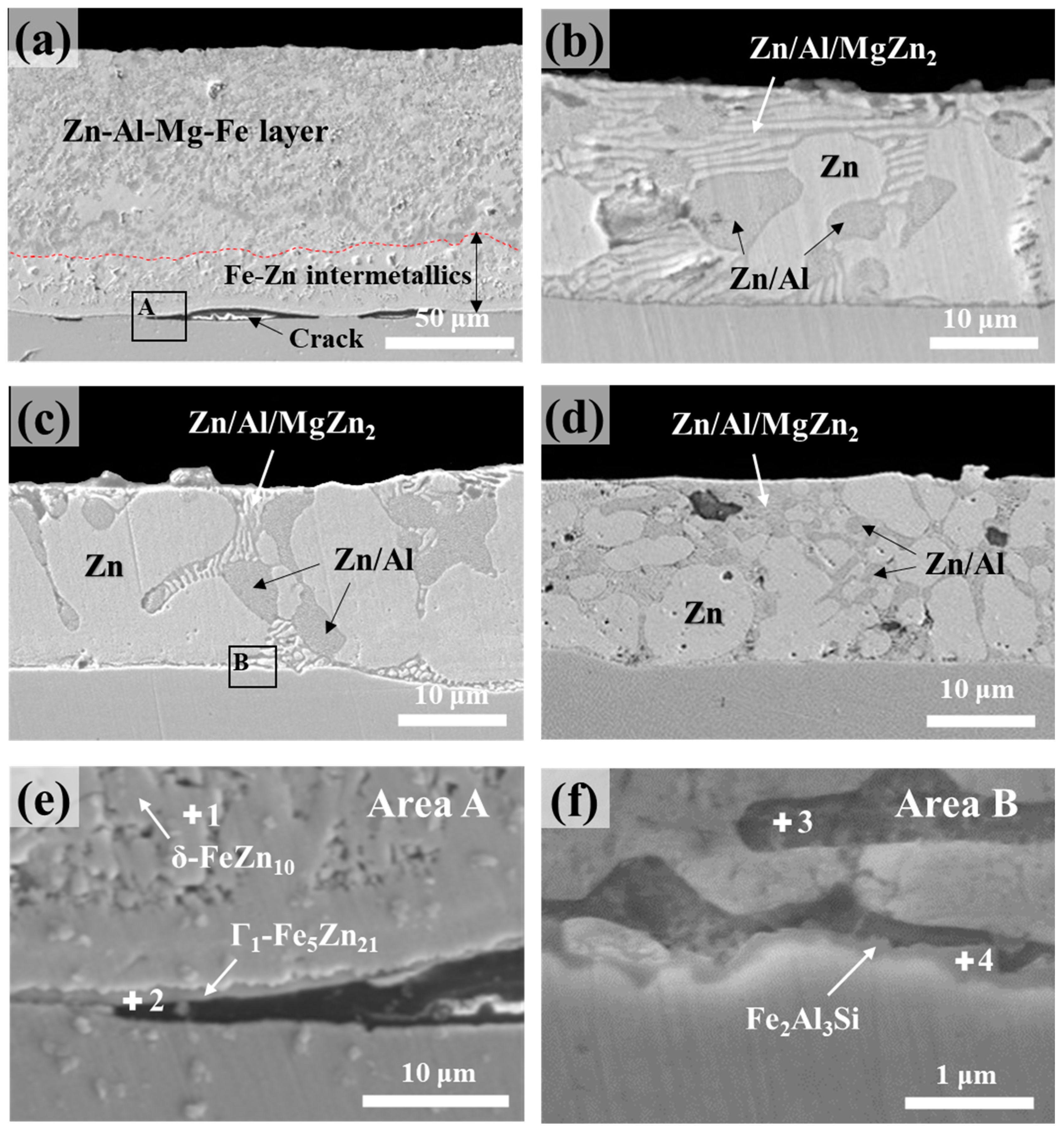
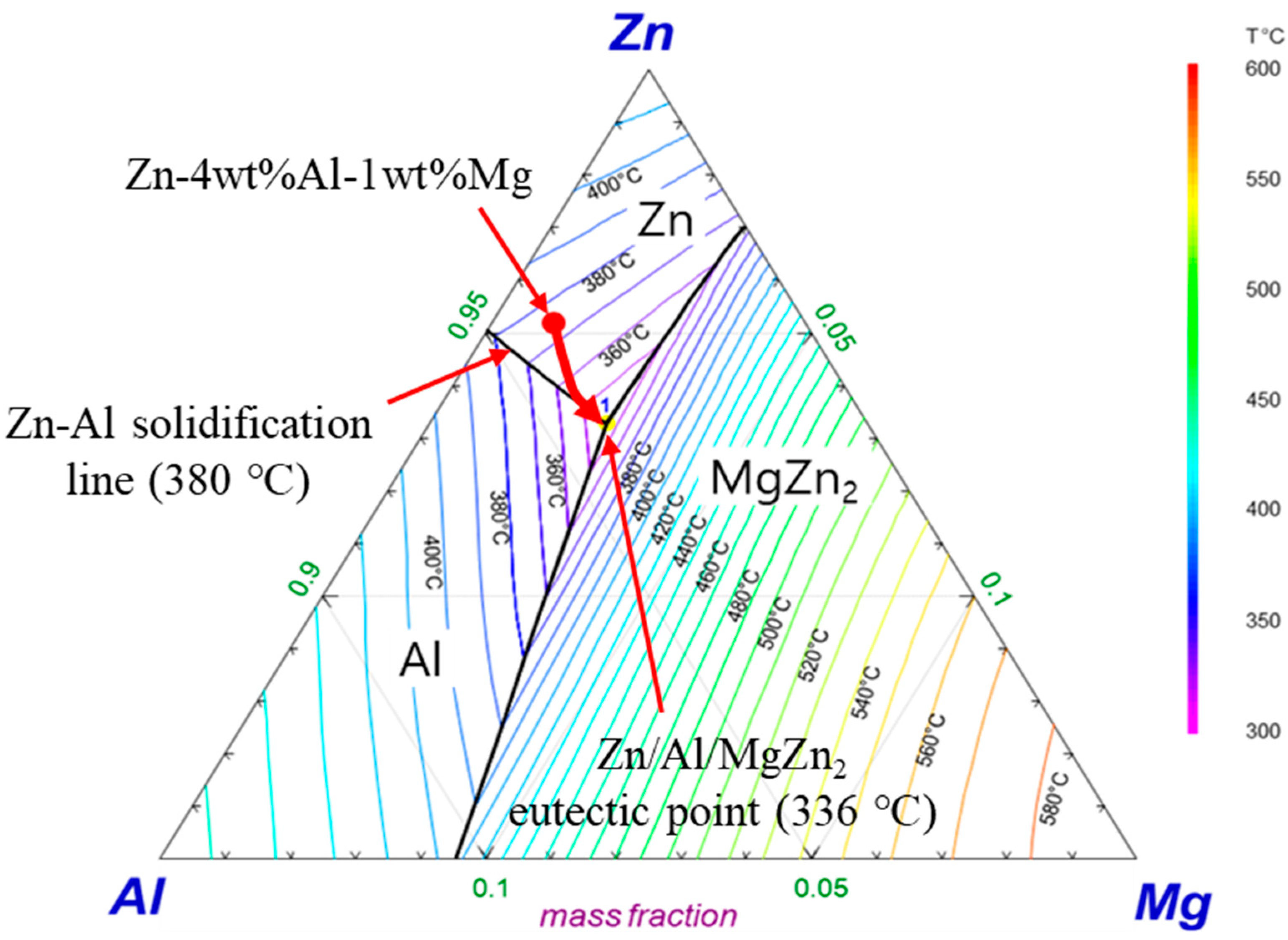

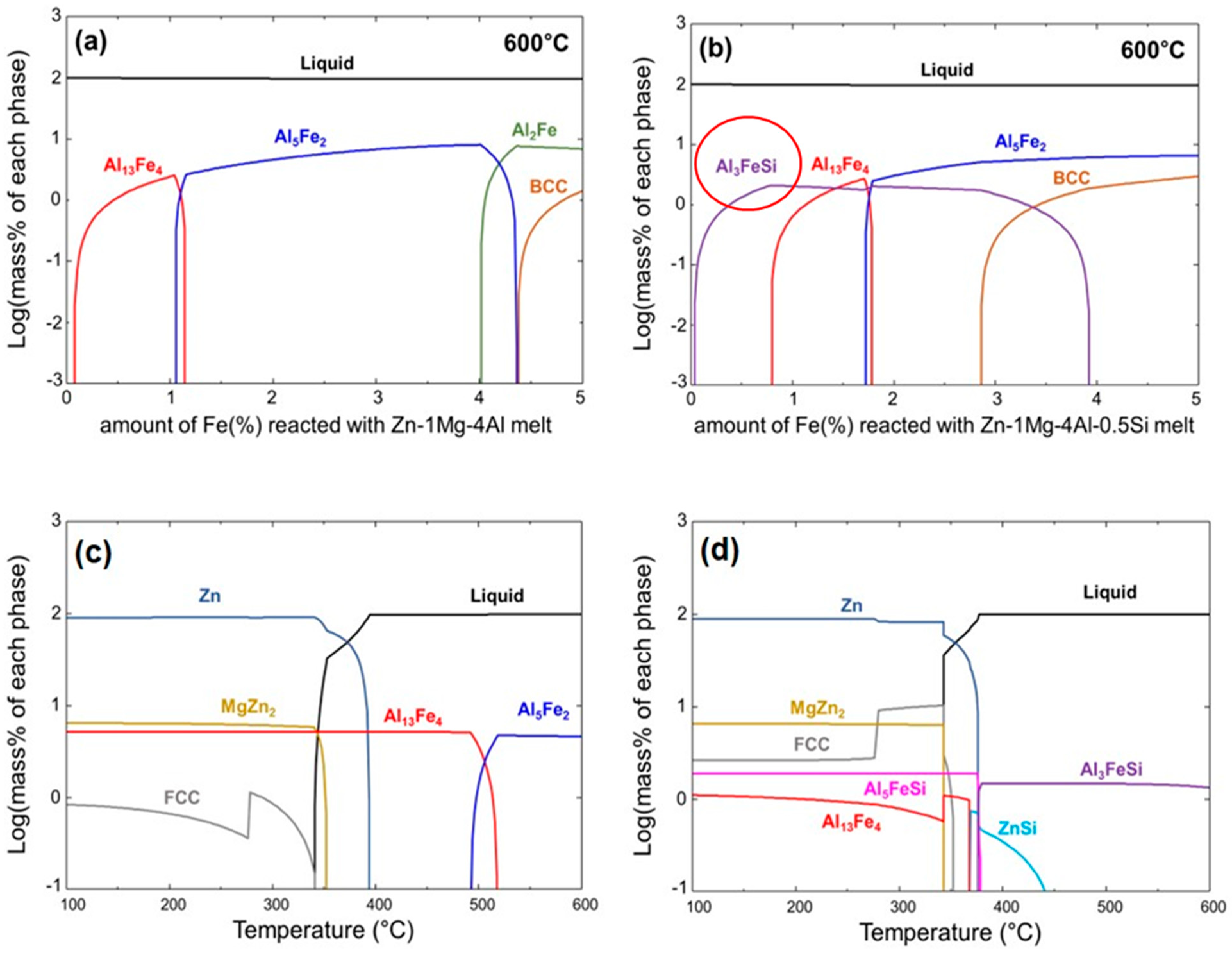
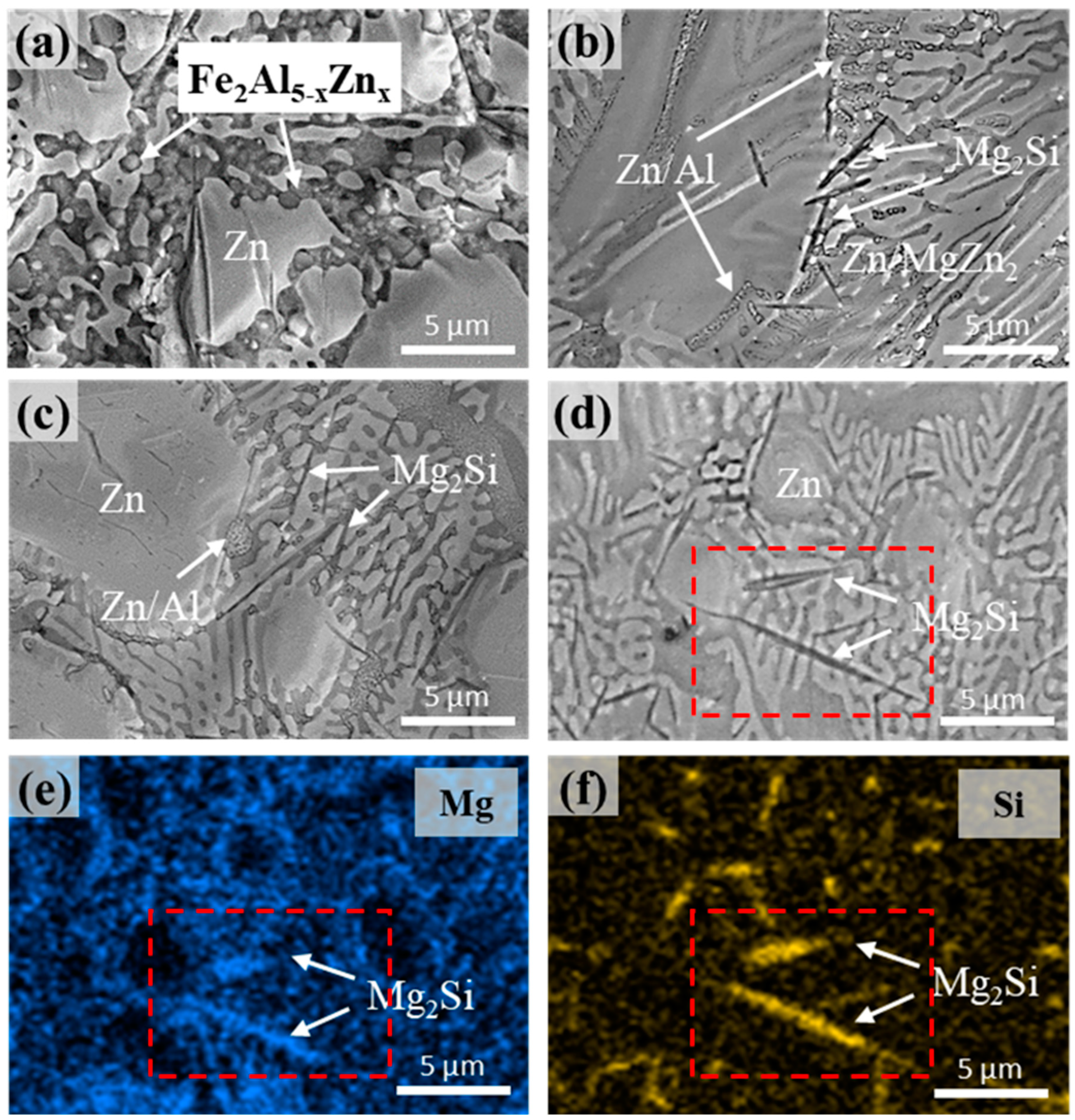


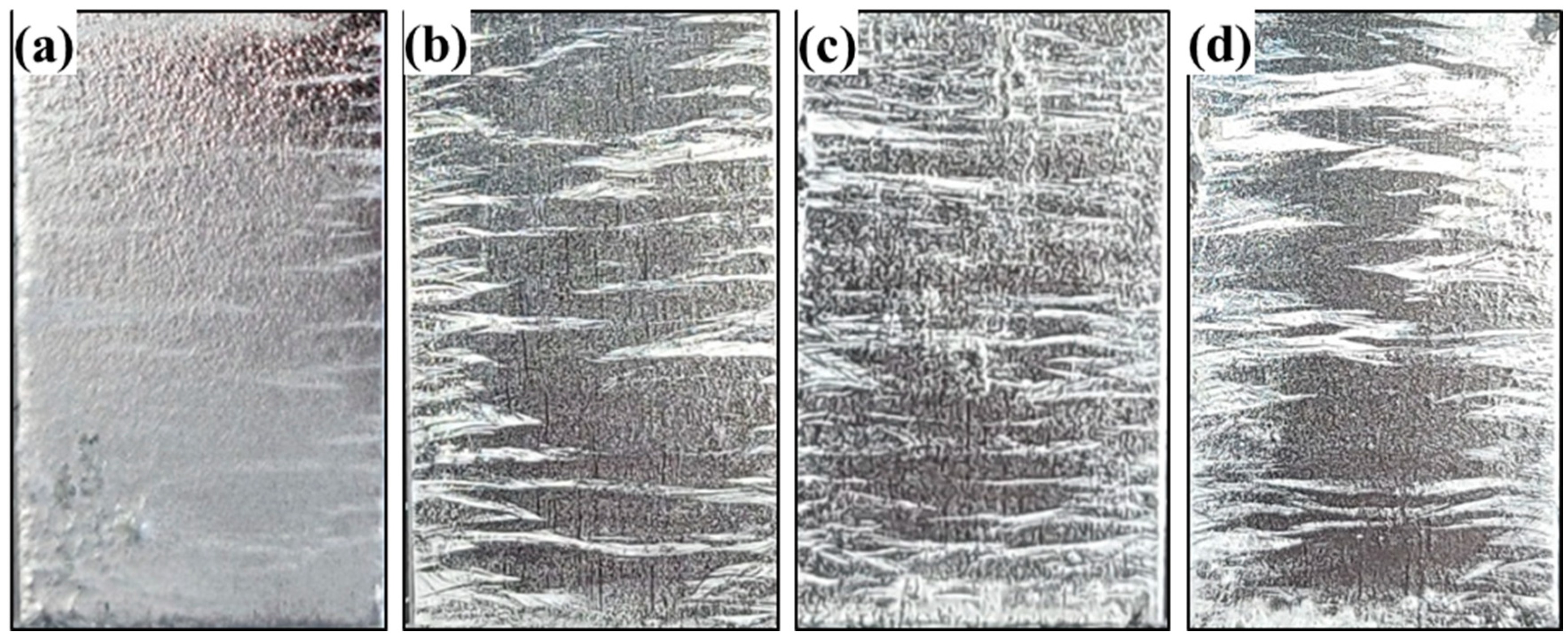


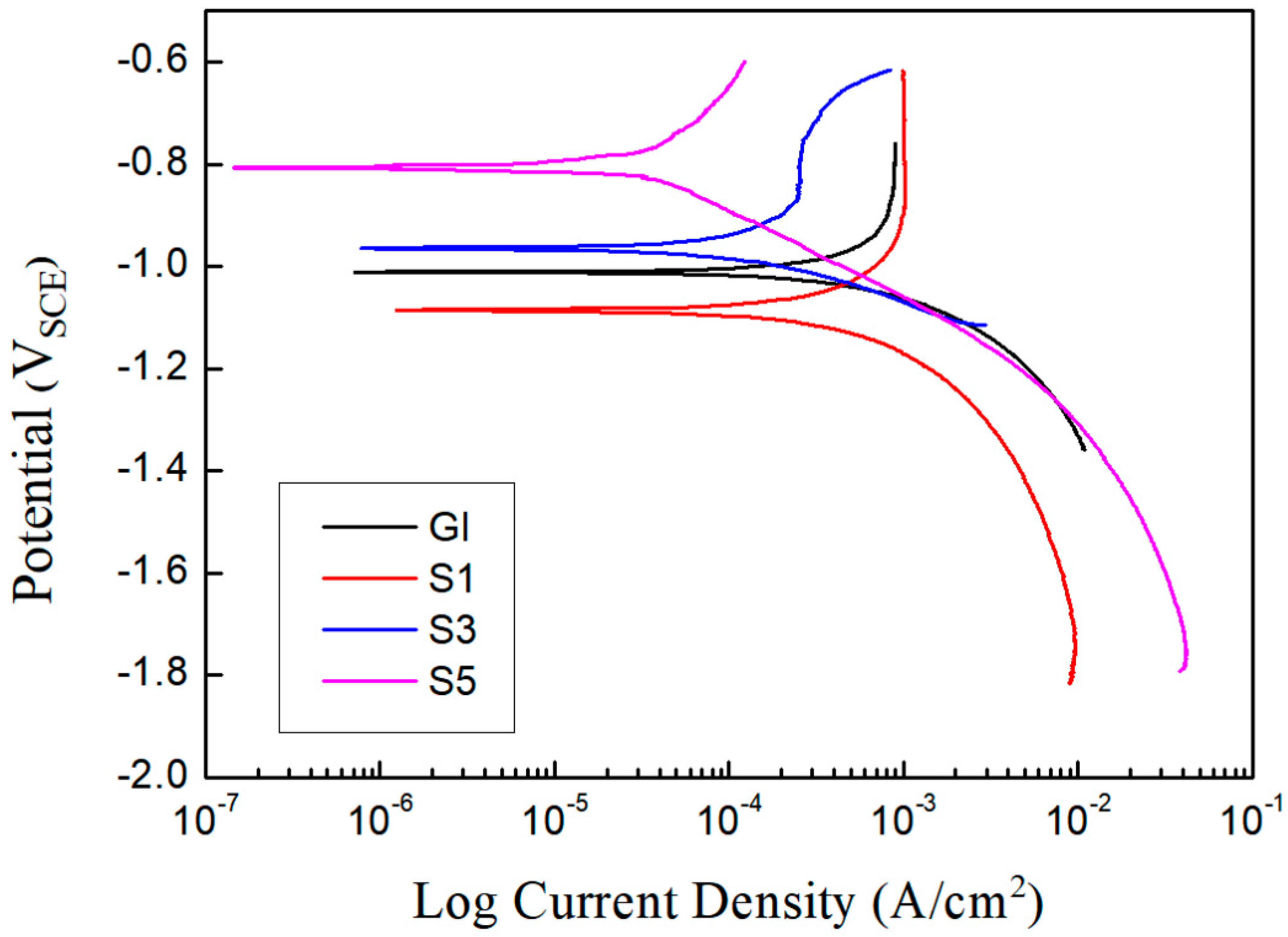

| Sample | Chemical Composition (wt.%) | ||||
|---|---|---|---|---|---|
| Al | Mg | Si | Fe | Zn | |
| S0 | 4.12 | 1.02 | - | 0.22 | Bal. |
| S1 | 4.2 | 1.14 | 0.09 | 0.14 | |
| S3 | 4.18 | 1.2 | 0.31 | 0.18 | |
| S5 | 4.14 | 1.13 | 0.46 | 0.15 | |
| Point | Chemical Composition (at.%) | |||||
|---|---|---|---|---|---|---|
| Mg | Al | Si | Fe | Zn | Phase | |
| 1 | 0.42 ± 0.28 | 1.66 ± 0.08 | - | 9.55 ± 0.32 | Bal. | δ |
| 2 | 0.62 ± 0.51 | 0.47 ± 0.41 | - | 32.06 ± 2.92 | Γ | |
| 3 | 25.72 ± 0.32 | 1.98 ± 0.12 | 0.09 ± 0.02 | 2.98 ± 0.11 | MgZn2 | |
| 4 | 2.32 ± 0.23 | 25.03 ± 1.12 | 16.32 ± 2.32 | 34.02 ± 0.58 | FeAl3Si | |
| Sample | Ecorr (VSCE) | icorr × 10−6 (A/cm2) |
|---|---|---|
| GI | −1.060 ± 0.01 | 7.690 ± 0.01 |
| S1 | −1.085 ± 0.05 | 1.246 ± 0.2 |
| S3 | −0.964 ± 0.05 | 0.776 ± 0.01 |
| S5 | −0.807 ± 0.03 | 0.145 ± 0.02 |
Disclaimer/Publisher’s Note: The statements, opinions and data contained in all publications are solely those of the individual author(s) and contributor(s) and not of MDPI and/or the editor(s). MDPI and/or the editor(s) disclaim responsibility for any injury to people or property resulting from any ideas, methods, instructions or products referred to in the content. |
© 2024 by the authors. Licensee MDPI, Basel, Switzerland. This article is an open access article distributed under the terms and conditions of the Creative Commons Attribution (CC BY) license (https://creativecommons.org/licenses/by/4.0/).
Share and Cite
So, S.-M.; Grandhi, S.; Kwon, E.-P.; Oh, M.-S. Effects of Si Addition on Interfacial Microstructure and Corrosion Resistance of Hot-Dip Zn–Al–Mg–Si Alloy-Coated Steel. Crystals 2024, 14, 294. https://doi.org/10.3390/cryst14040294
So S-M, Grandhi S, Kwon E-P, Oh M-S. Effects of Si Addition on Interfacial Microstructure and Corrosion Resistance of Hot-Dip Zn–Al–Mg–Si Alloy-Coated Steel. Crystals. 2024; 14(4):294. https://doi.org/10.3390/cryst14040294
Chicago/Turabian StyleSo, Seong-Min, Srinivasulu Grandhi, Eui-Pyo Kwon, and Min-Suk Oh. 2024. "Effects of Si Addition on Interfacial Microstructure and Corrosion Resistance of Hot-Dip Zn–Al–Mg–Si Alloy-Coated Steel" Crystals 14, no. 4: 294. https://doi.org/10.3390/cryst14040294
APA StyleSo, S.-M., Grandhi, S., Kwon, E.-P., & Oh, M.-S. (2024). Effects of Si Addition on Interfacial Microstructure and Corrosion Resistance of Hot-Dip Zn–Al–Mg–Si Alloy-Coated Steel. Crystals, 14(4), 294. https://doi.org/10.3390/cryst14040294






